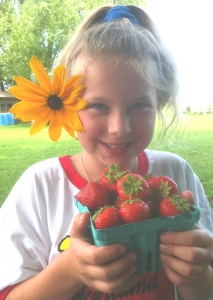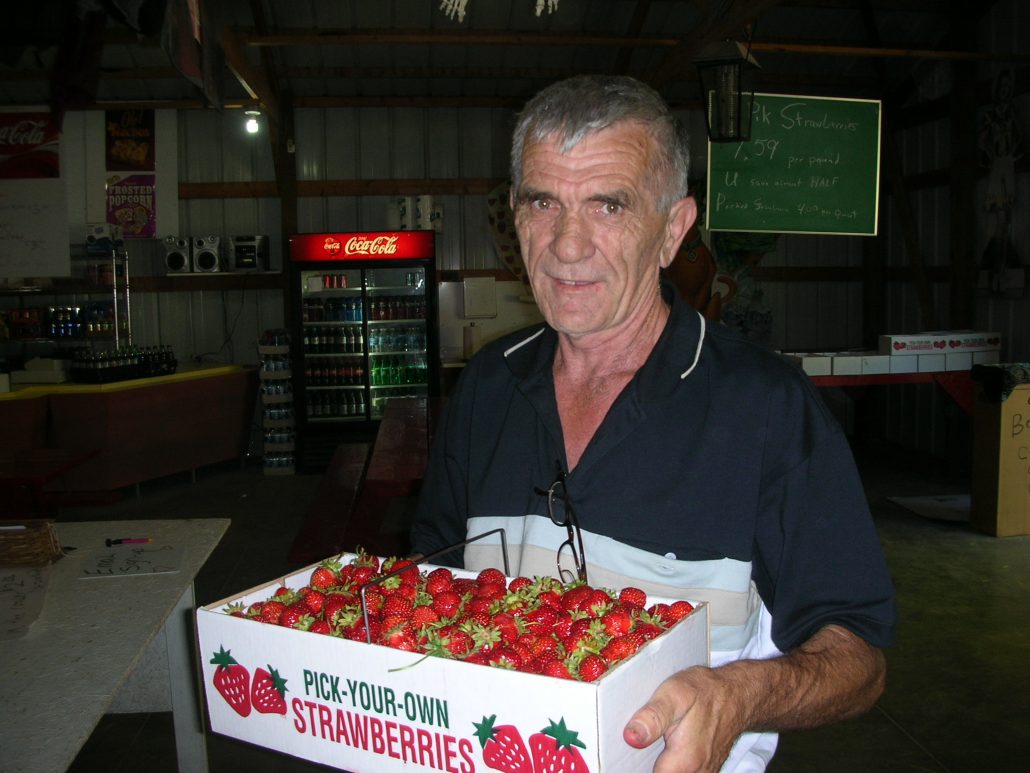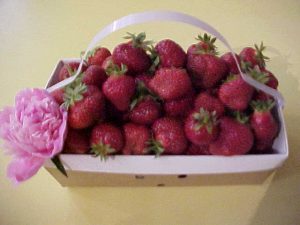STRAWBERRY SEASON
Everybody knows strawberries taste fantastic. Next, know where to get the best tasting, sun ripened, farm fresh strawberries possible. Straight from the farm of course
What: STRAWBERRIES farm fresh, sun ripened, and locally grown
When: Everyday through strawberry season 8AM till 7PM
How: Sold at the farm, pick your own $3.89 per pound or buy ready picked $7 per quart

No Time? Can’t Pick? Get ’em at the Cooler!
Quick & Convenient Farm Fresh, Sun Ripened Strawberries Picked Daily at Our Farm
CALL 23 BERRY (232-3779)
Please call for current picking conditions and to verify availability.
We also except Credit Cards and Debit Cards
Come Out To The Farm. We Look Forward To Seeing You!

DID YOU KNOW?
Strawberries are a member of the Rose family. Strawberries are unique in that they have seeds on the outside. All other berries (blueberry, raspberry) have seeds on the inside. The modern strawberry is a criss-crossed hybrid of native wild strawberries (F. virginiana) from Eastern North America, (F. ovalis) the Rocky Mountain strawberry and the South American Chilian strawberry (F. chiloensis).
Strawberries have been growing wild for thousands years and are native to every continent except Africa and Austrailia. Today their are over 200 varieties of strawberries cultivated around the world. “Strawberry” may well be the favorite flavor of the US, chocolate is the only other flavor that comes even close.
Royalty and scholars through the centuries have praised stawberries as one of the finest gifts of God. Romans thought strawberries to have therapeutic powers and later the French claimed strawberries to have aphrodisiac powers. Very nutritious, strawberries are higher in vitamin C than oranges. Today scientists know strawberries contain a phenolic compound called ellagic acid that is known to have anticarcinogenic activity. The latest claim to fame for strawberries is that they are a rich source of phytonutients. Go ahead, enjoy, indulge, Strawberries are one of the few foods that taste so good and are so good for you.
History
A Lesson in Strawberry History
 Strawberries were first sold in a London marketplace around 1831. They were most likely harvested from wild strawberries in nearby fields or woodlands and not from “commercial” production areas. In England and Europe the consumption of strawberries became increasingly more popular, many peasants as well as aristocrats would have a patch in their home gardens. France, though, became the the front runner in strawberry production.
The word Strawberry is in itself, unique to the English language. The name has a variety of posssible origins. Straw was commonly used to mulch the plants during the winter and to keep the berries cleaner. In London children used to pick the berries, hang them on pieces of straw then sell them in the street markets as “Straws of Berries”. The runners which the plants produce are said to be strewn or dispersed around the plant. In some literature the fruit is called strewberry. In Latin the fruit is referred to as “Fragra” or Fragrant. Charles Linneaus gave strawberry the scientific species name of Fragaria. In French, Italian, and Spanish the fruit is refered to as a “Fraise” or fragrant berry. In North America The Narragansett Indians called the fruit “wuttahimneash” or “heart berry”.
French explorer Cartier brought strawberries to France from the Quebec Province of Canada in 1534. Englands explorer, Hariot, brought back strawberry plant specemins from Virginia to London. Other strawberry plants were brought to Europe from the South American Andes mountain region where they had been cultivated and marketed long before the Spanish arrived. The strawberry plants found native in the Americas, were superior to all European varieties in size, flavor, and beauty. The gardens at Versailles France were among the first to seriously work at improved production of strawberries. In the 18th Century one of the first breeding crosses was made to improve the strawberry. A Virginia variety was crossed with a Chilean variety which lent the resultant offspring both size and firmness. This variety, the first hybrid, became known as the Pineapple or Pine strawberry due to its distinctive flavor.
Strawberries were first sold in a London marketplace around 1831. They were most likely harvested from wild strawberries in nearby fields or woodlands and not from “commercial” production areas. In England and Europe the consumption of strawberries became increasingly more popular, many peasants as well as aristocrats would have a patch in their home gardens. France, though, became the the front runner in strawberry production.
The word Strawberry is in itself, unique to the English language. The name has a variety of posssible origins. Straw was commonly used to mulch the plants during the winter and to keep the berries cleaner. In London children used to pick the berries, hang them on pieces of straw then sell them in the street markets as “Straws of Berries”. The runners which the plants produce are said to be strewn or dispersed around the plant. In some literature the fruit is called strewberry. In Latin the fruit is referred to as “Fragra” or Fragrant. Charles Linneaus gave strawberry the scientific species name of Fragaria. In French, Italian, and Spanish the fruit is refered to as a “Fraise” or fragrant berry. In North America The Narragansett Indians called the fruit “wuttahimneash” or “heart berry”.
French explorer Cartier brought strawberries to France from the Quebec Province of Canada in 1534. Englands explorer, Hariot, brought back strawberry plant specemins from Virginia to London. Other strawberry plants were brought to Europe from the South American Andes mountain region where they had been cultivated and marketed long before the Spanish arrived. The strawberry plants found native in the Americas, were superior to all European varieties in size, flavor, and beauty. The gardens at Versailles France were among the first to seriously work at improved production of strawberries. In the 18th Century one of the first breeding crosses was made to improve the strawberry. A Virginia variety was crossed with a Chilean variety which lent the resultant offspring both size and firmness. This variety, the first hybrid, became known as the Pineapple or Pine strawberry due to its distinctive flavor.
- USA, 1780 “Hudson” was the first strawberry hybrid developed North America. Strawberries were first shiped using ice as “refridgeration” in 1843 from Cincinatti Ohio. This technique increased marketing potential and gave customers better quality fruit and an even greater increase in popularity.
- “Doubtless God could have made a better berry, but doubtless God never did.” (Dr. William Butler, 17th Century English Writer) Dr. Butler is referring to the strawberry.
- In Othello, Shakespeare decorated Desdemonda’s handkerchief with symbolic strawberries.
- Madame Tallien, a prominent figure at the court of the Emperor Napoleon, was famous for bathing in the juice of fresh strawberries.
- In Greek and Roman times, the strawberry was a wild plant.In parts of Bavaria, country folk still practice the annual rite each spring of tying small baskets of wild strawberries to the horns of their cattle as an offering to elves
- The American Indians were already eating strawberries when the Colonists arrived. The crushed berries were mixed with cornmeal and baked into strawberry bread. Colonists developed their own version of the recipe and Strawberry Shortcake was created.
- The English “strawberry” comes from the Anglo-Saxon “streoberie” not spelled in the modern fashion until 1538
- The first documented botanical illustration of a strawberry plant appeared as a figure in Herbaries in 1454
- Legend has it that if you break a double strawberry in half and share it with a member of the opposite sex, you will fall in love with each other he strawberry was a symbol for Venus, the Goddess of Love, because of its heart shapes and red color.
- To symbolize perfection and righteousness, medieval stone masons carved strawberry designs on altars and around the tops of pillars in churches and cathedral
- The wide distribution of wild strawberries is largely from seeds sown by birds. It seems that when birds eat the wild berries the seeds pass through them intact and in reasonably good condition. The germinating seeds respond to light rather than moisture and therefore need no covering of earth to start growing.
Medicinal Uses
The strawberry, a member of the rose family, is unique in that it is the only fruit with seeds on the outside rather than the inside. Many medicinal uses were claimed for the wild strawberry, its leaves and root.
The ancient Romans believed that the berries alleviated symptoms of melancholy, fainting, all inflammations, fevers, throat infections, kidney stones, halitosis, attacks of gout, and diseases of the blood, liver and spleen.
“Nutriceutical” is one of the latest words to describe the many healthful compounds being identified in fruits and vegetables in recent years. This is how todays scientists are merely repeating in “scientific notation” what the scholars and learned men of the past few thousand years knew all along. Interesting how history repeats itself. Is this really new information, or just a new understanding of ancient wisdom.
Fun Facts About Strawberries
- Over 53 percent of seven to nine year olds picked strawberries as their favorite fruit.

- Eight strawberries will provide 140 percent of the recommended daily intake of Vitamin C for kids.
- Strawberries adapt to various climates and are native to every major continent except Africa, Australia and New Zealand.
- The fruit size of the very early strawberries was very small.
- Strawberries are a member of the rose family.
- Strawberries are the first fruit to ripen in the spring.
- The strawberry is the only fruit with the seeds on the outside of the fruit.
- There is a museum in Belgium just for strawberries.
- Seventy per cent of a strawberry’s roots are located in the top 1 foot of soil.
- The flavor of a strawberry is influenced by weather, the variety and stage of ripeness when harvested.
- On average, there are 200 seeds in a strawberry.
- One cup of strawberries is about 60 calories
- Over Ninety per cent of United States households consume strawberries.
- According to the United States Department of Agriculture, the annual per capita consumption of fresh and frozen strawberries is nearly 5 pounds.
- Strawberries are grown in every state in the United States and every province of Canada.
- California produces well over half of the nation’s strawberry crops.
- If all the strawberries produced in California in one year were laid berry to berry, they would go around the world 15 times.
- Americans eat 3.4 pounds of fresh strawberries each year plus another 1.8 pounds frozen per capita. Although strawberries are available in many forms—frozen, jam and jelly, and ice cream— nothing compares to the taste of a fresh vine ripened strawberry.
- Strawberries are delicate, requiring gentle handling to prevent bruising. With today’s shipping technology, strawberries are available year round, but at a cost. Commercial growers have produced resilient hybrid berries known for their shipping quality.
- Florida is second in production. The Florida season runs from December to May and peaks during March and April. To meet the demand, winter strawberries are usually imported between November and May
- The upper midwest was at one time the leading strawberry production area of the nation and still produces a significant amount of June crop strawberries. California and Florida grow day-nuetral varieties.
The ancient Romans believed that the berries alleviated symptoms of melancholy, fainting, all inflammations, fevers, throat infections, kidney stones, halitosis, attacks of gout, and diseases of the blood, liver and spleen.
“Nutriceutical” is one of the latest words to describe the many healthful compounds being identified in fruits and vegetables in recent years. This is how todays scientists are merely repeating in “scientific notation” what the scholars and learned men of the past few thousand years knew all along. Interesting how history repeats itself. Is this really new information, or just a new understanding of ancient wisdom.
Health & Nutrition Information
 The Romans prized wild strawberries for their medicinal properties. Ounce for ounce, strawberries have more Vitamin C than citrus fruit. According to the American Cancer Society, foods rich in Vitamin C may lower the risk of cancers of the gastrointestinal tract.
The Romans prized wild strawberries for their medicinal properties. Ounce for ounce, strawberries have more Vitamin C than citrus fruit. According to the American Cancer Society, foods rich in Vitamin C may lower the risk of cancers of the gastrointestinal tract.
A strawberry is a superstar when it comes to anti-oxidant power, according to Dr. Barry Sears in his book The Top 100 Zone Foods. In addition, 1 cup of strawberries gives you a whopping 140 percent of your recommended daily allowance of vitamin C. Strawberries are also packed with flavonoids, two in particular, called quercetin and kaempferol. Research shows that these two flavonoids help keep “bad” (LDL) cholesterol from oxidizing and damaging artery walls.
Strawberries also contain ellargic acid — also found in raspberries, blackberries, cranberries, grapes, cherries, walnuts, pecans and Brazil nuts — which acts as a scavenger to “bind” cancer-causing chemicals, making them inactive. It inhibits the ability of other chemicals to cause mutations in bacteria. In addition, it prevents binding of carcinogens to DNA and reduces the incidence of cancer in cultured human cells exposed to carcinogens.
Nutrition Facts
Serving Size: 1 cup sliced fresh strawberries (166 grams)
Calories 50
Protein 1 gram
Carbohydrates 11.65 grams
Dietary Fiber 3.81 grams
Calcium 23.24 mg
Iron 0.63 mg
Magnesium 16.60 mg
Phosphorus 31.54 mg
Potassium 44.82 mg
Selenium 1.16 mg
Vitamin C 94.12 mg
Folate 29.38 mcg
Vitamin A 44..82 IU
When Measuring Strawberries
1 1/2 pounds = 1 quart = 2 pints (aproximate, affected by berry size and moisure content)
1 small basket = 1 pint
1 pint = 3 1/4 cups whole berries
1 pint = 2 1/4 cups sliced berries
1 pint – 1 2/3 cup pureed berries
1 cup = about 4 ounces
Freezing Strawberries
We have tried many techniques over the years, whole strawberries, sliced, crushed, mashed with and without sugar. This is the easieast, best tasting method and gives long storage.
- Clean the berries, rinse and drain excess water. Don’t cut or cap berries until after cleaned and drained.
- Cap, hull or stem (remove the green calix) the berries. Cut away any soft or damaged spots. It is important not to soak berries after they are caped or cut. Water will soak into the berries, berry juice is lost to the water and this changes the flavor.
- Put in a large container and spinkle enough white sugar to lightly coat the berries. Gently stir or fold until sugar make a light glaze on the berries. Don’t overdo this, just enough to spread sugar around and coat the berries. This helps protect the flavor during frozen storage. How much sugar? We like about 1 cup sugar to 10 cups cleaned berries. More or less to your taste.
- Pack in your choice of freezer containers or bags. Here is the key, get all the air out. Compress berries as needed to eliminate air bubbles and air spaces between berries. Slice or mash if you like, this only changes shape of the berries. Seal the container, remember no air in the container only berries. Ziplock bags work great. Better to ooze a little juice out as you close it than to leave air in the bag.
- Whole berries can be frozen in like manner with or without the cap. Her is the catch, the air being all around the berries will allow “freezer burn”. Freezer burn is a combination of moisture loss and oxidation, nasty.
- Colder is better in storage. Ten degrees below zero is recommended.
